2001 MERCEDES-BENZ E-Class WAGON window
[x] Cancel search: windowPage 220 of 345
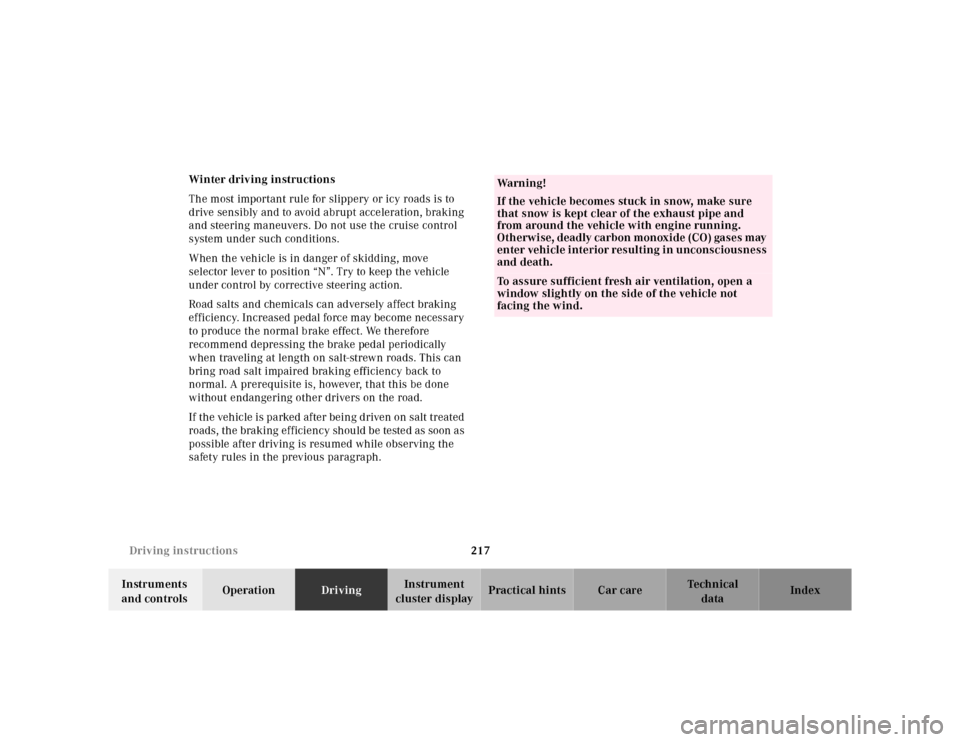
217 Driving instructions
Te ch n ica l
data Instruments
and controlsOperationDrivingInstrument
cluster displayPractical hints Car care Index Winter driving instructions
The most important rule for slippery or icy roads is to
drive sensibly and to avoid abrupt acceleration, braking
and steering maneuvers. Do not use the cruise control
system under such conditions.
When the vehicle is in danger of skidding, move
selector lever to position “N”. Try to keep the vehicle
under control by corrective steering action.
Road salts and chemicals can adversely affect braking
efficiency. Increased pedal force may become necessary
to produce the normal brake effect. We therefore
recommend depressing the brake pedal periodically
when traveling at length on salt-strewn roads. This can
bring road salt impaired braking efficiency back to
normal. A prerequisite is, however, that this be done
without endangering other drivers on the road.
If the vehicle is parked after being driven on salt treated
roads, th e bra king ef f iciency sh ou ld b e teste d as soon a s
possible after driving is resumed while observing the
safety rules in the previous paragraph.
Wa r n i n g !
If the vehicle becomes stuck in snow, make sure
that snow is kept clear of the exhaust pipe and
from around the vehicle with engine running.
Otherwise, deadly carbon monoxide (CO) gases may
enter vehicle interior resulting in unconsciousness
and death.To assure sufficient fresh air ventilation, open a
window slightly on the side of the vehicle not
facing the wind.
Page 287 of 345
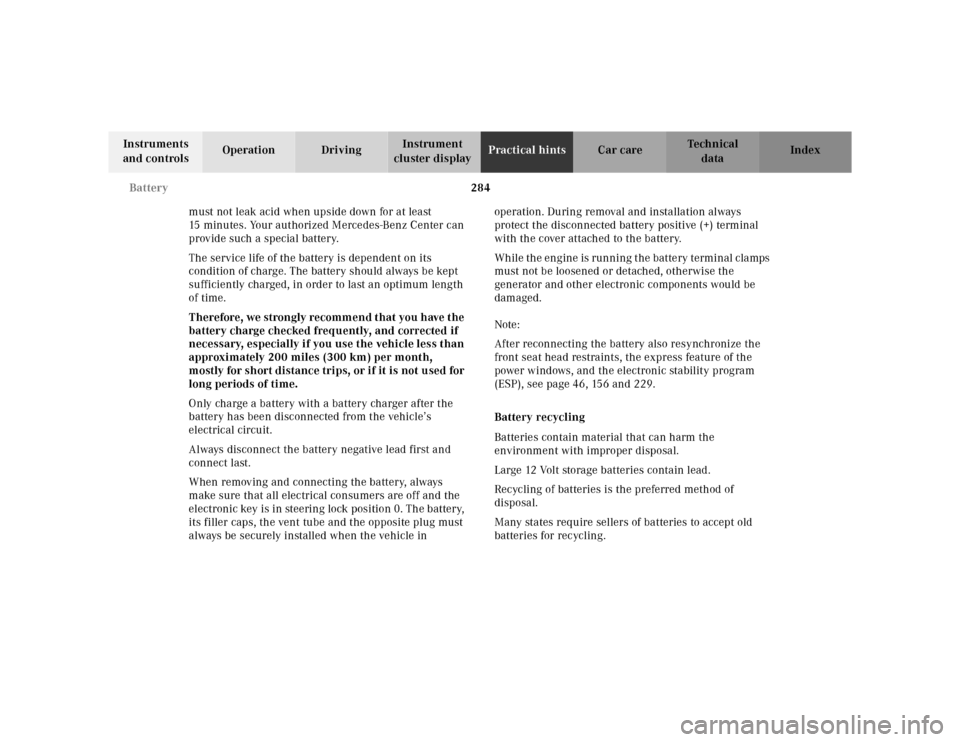
284 Battery
Te ch n ica l
data Instruments
and controlsOperation DrivingInstrument
cluster displayPractical hintsCar care Index
must not leak acid when upside down for at least
15 minutes. Your authorized Mercedes-Benz Center can
provide such a special battery.
The service life of the battery is dependent on its
condition of charge. The battery should always be kept
sufficiently charged, in order to last an optimum length
of time.
Therefore, we strongly recommend that you have the
battery charge checked frequently, and corrected if
necessary, especially if you use the vehicle less than
approximately 200 miles (300 km) per month,
mostly for short distance trips, or if it is not used for
long periods of time.
Only charge a battery with a battery charger after the
battery has been disconnected from the vehicle’s
electrical circuit.
Always disconnect the battery negative lead first and
connect last.
When removing and connecting the battery, always
make sure that all electrical consumers are off and the
electronic key is in steering lock position 0. The battery,
its filler caps, the vent tube and the opposite plug must
always be securely installed when the vehicle in operation. During removal and installation always
protect the disconnected battery positive (+) terminal
with the cover attached to the battery.
While the engine is running the battery terminal clamps
must not be loosened or detached, otherwise the
generator and other electronic components would be
damaged.
Note:
After reconnecting the battery also resynchronize the
front seat head restraints, the express feature of the
power windows, and the electronic stability program
(ESP), see page 46, 156 and 229.
Battery recycling
Batteries contain material that can harm the
environment with improper disposal.
Large 12 Volt storage batteries contain lead.
Recycling of batteries is the preferred method of
disposal.
Many states require sellers of batteries to accept old
batteries for recycling.
Page 307 of 345
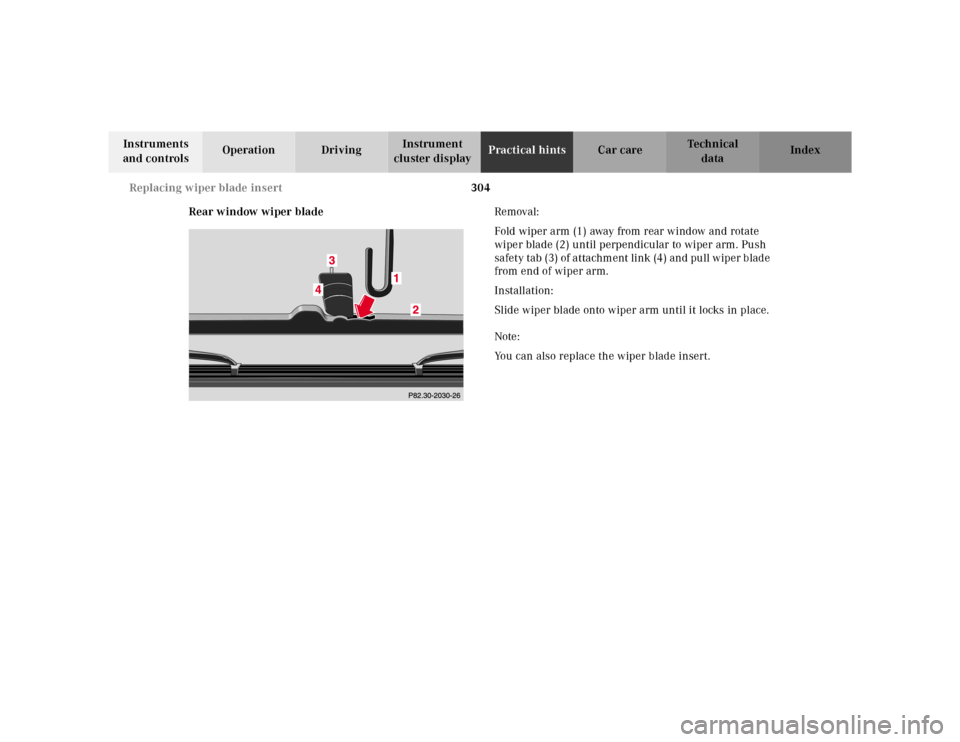
304 Replacing wiper blade insert
Te ch n ica l
data Instruments
and controlsOperation DrivingInstrument
cluster displayPractical hintsCar care Index
Rear window wiper bladeRemoval:
Fold wiper arm (1) away from rear window and rotate
wiper blade (2) until perpendicular to wiper arm. Push
safety tab (3) of attachment link (4) and pull wiper blade
from end of wiper arm.
Installation:
Slide wiper blade onto wiper arm until it locks in place.
Note:
You can also replace the wiper blade insert.
Page 310 of 345

307 Contents - Vehicle care
Te ch n ica l
data Instruments
and controlsOperation DrivingInstrument
cluster displayPractical hintsCar careIndex
Vehicle careCleaning and care of
the vehicle .................................. 308
Power washer ..............................309
Tar stains .....................................309
Paintwork, painted body
components .................................309
Engine cleaning .......................... 310Vehicle washing ..........................310
Ornamental moldings ................310
Headlamps, taillamps,
turn signal lenses .......................310
Cleaning the parktronic
system sensors ............................ 311
Window cleaning ........................ 311
Wiper blades ............................... 311
Light alloy wheels ......................312Instrument cluster ..................... 312
Steering wheel and
gear selector lever ...................... 312
Cup holder ................................... 312
Seat belts ..................................... 312
Headliner ..................................... 312
Upholstery ................................... 313
Hard plastic trim items ............. 313
Plastic and rubber parts ............ 313
Page 311 of 345
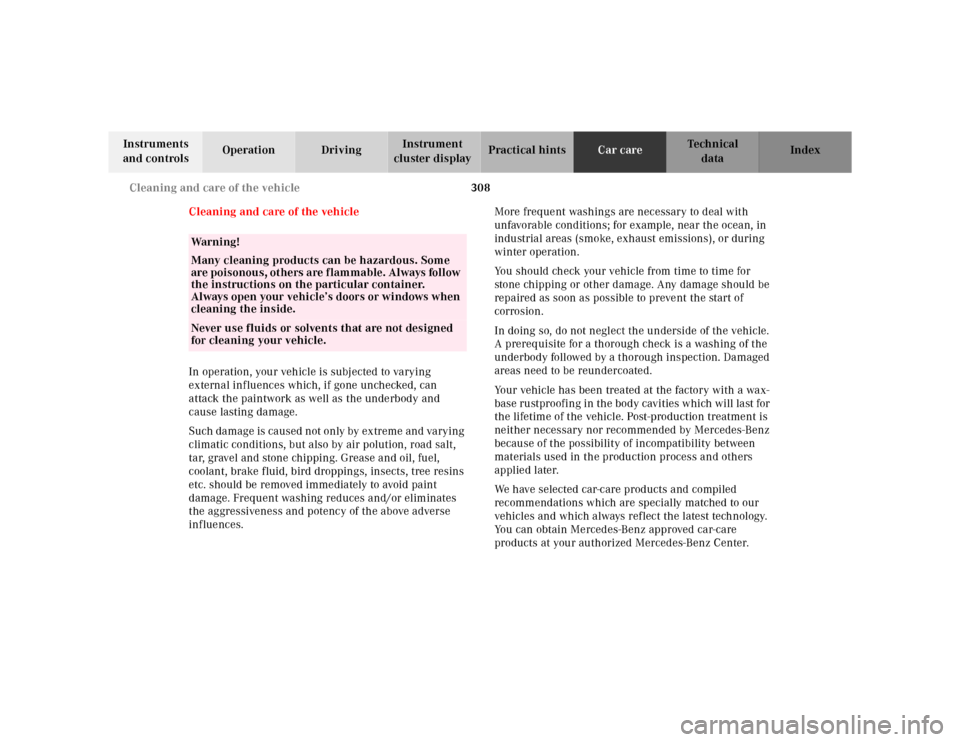
308 Cleaning and care of the vehicle
Te ch n ica l
data Instruments
and controlsOperation DrivingInstrument
cluster displayPractical hintsCar careIndex
Cleaning and care of the vehicle
In operation, your vehicle is subjected to varying
external influences which, if gone unchecked, can
attack the paintwork as well as the underbody and
cause lasting damage.
Such damage is caused not only by extreme and varying
climatic conditions, but also by air polution, road salt,
tar, gravel and stone chipping. Grease and oil, fuel,
coolant, brake fluid, bird droppings, insects, tree resins
etc. should be removed immediately to avoid paint
damage. Frequent washing reduces and/or eliminates
the aggressiveness and potency of the above adverse
influences.More frequent washings are necessary to deal with
unfavorable conditions; for example, near the ocean, in
industrial areas (smoke, exhaust emissions), or during
winter operation.
You should check your vehicle from time to time for
stone chipping or other damage. Any damage should be
repaired as soon as possible to prevent the start of
corrosion.
In doing so, do not neglect the underside of the vehicle.
A prerequisite for a thorough check is a washing of the
underbody followed by a thorough inspection. Damaged
areas need to be reundercoated.
Your vehicle has been treated at the factory with a wax-
base ru stproof ing in th e body cavities w hich will la st for
the lifetime of the vehicle. Post-production treatment is
neither necessary nor recommended by Mercedes-Benz
because of the possibility of incompatibility between
materials used in the production process and others
applied later.
We have selected car-care products and compiled
recommendations which are specially matched to our
vehicles and which always reflect the latest technology.
You can obtain Mercedes-Benz approved car-care
products at your authorized Mercedes-Benz Center.
Wa r n i n g !
Many cleaning products can be hazardous. Some
are poisonous, others are flammable. Always follow
the instructions on the particular container.
Always open your vehicle’s doors or windows when
cleaning the inside.Never use fluids or solvents that are not designed
for cleaning your vehicle.
Page 314 of 345
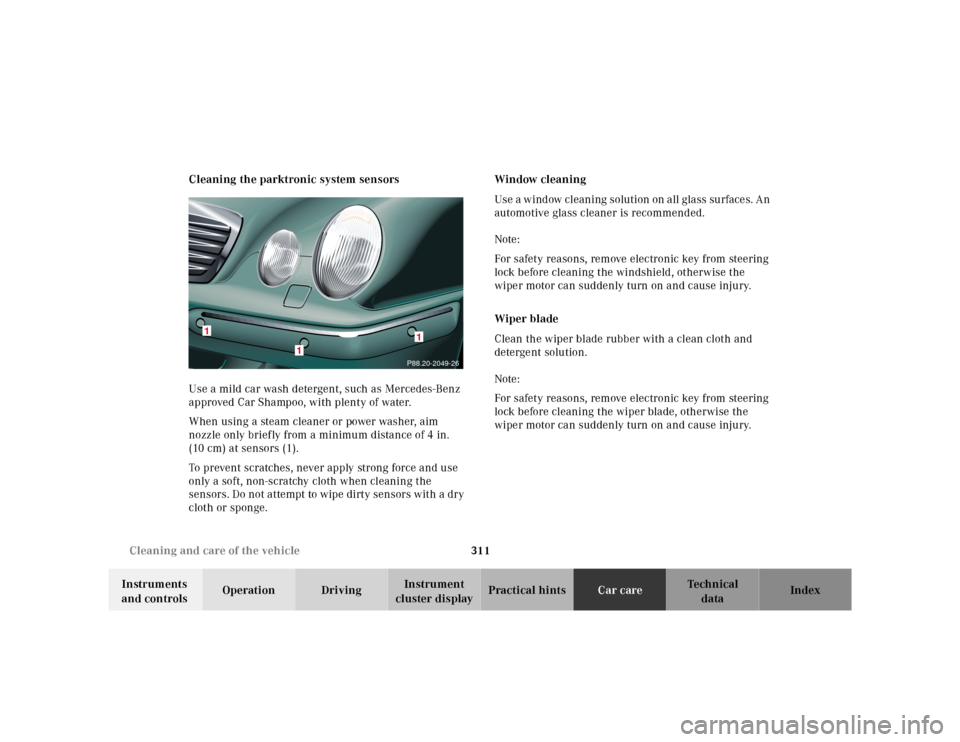
311 Cleaning and care of the vehicle
Te ch n ica l
data Instruments
and controlsOperation DrivingInstrument
cluster displayPractical hintsCar careIndex Cleaning the parktronic system sensors
Use a mild car wash detergent, such as Mercedes-Benz
approved Car Shampoo, with plenty of water.
When using a steam cleaner or power washer, aim
nozzle only briefly from a minimum distance of 4 in.
(10 cm) at sensors (1).
To prevent scratches, never apply strong force and use
only a soft, non-scratchy cloth when cleaning the
sensors. Do not attempt to wipe dirty sensors with a dry
cloth or sponge.Window cleaning
Use a window cleaning solution on all glass surfaces. An
automotive glass cleaner is recommended.
Note:
For safety reasons, remove electronic key from steering
lock before cleaning the windshield, otherwise the
wiper motor can suddenly turn on and cause injury.
Wiper blade
Clean the wiper blade rubber with a clean cloth and
detergent solution.
Note:
For safety reasons, remove electronic key from steering
lock before cleaning the wiper blade, otherwise the
wiper motor can suddenly turn on and cause injury.
P88.20-2049-261
1
1
Page 333 of 345
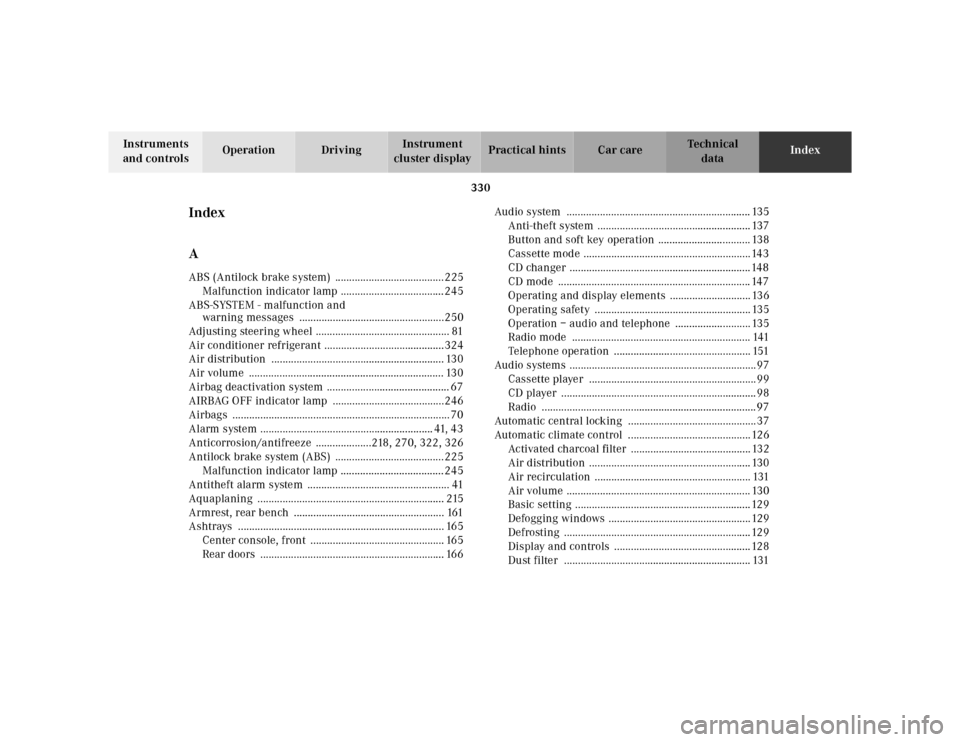
330
Te ch n ica l
data Instruments
and controlsOperation DrivingInstrument
cluster displayPractical hints Car careIndex
Index
AABS (Antilock brake system) .......................................225
Malfunction indicator lamp .....................................245
ABS-SYSTEM - malfunction and
warning messages ....................................................250
Adjusting steering wheel ................................................ 81
Air conditioner refrigerant ...........................................324
Air distribution .............................................................. 130
Air volume ...................................................................... 130
Airbag deactivation system ............................................ 67
AIRBAG OFF indicator lamp ........................................246
Airbags .............................................................................. 70
Alarm system .............................................................. 41, 43
Anticorrosion/antifreeze ....................218, 270, 322, 326
Antilock brake system (ABS) .......................................225
Malfunction indicator lamp .....................................245
Antitheft alarm system ................................................... 41
Aquaplaning ................................................................... 215
Armrest, rear bench ...................................................... 161
Ashtrays .......................................................................... 165
Center console, front ................................................ 165
Rear doors .................................................................. 166Audio system .................................................................. 135
Anti-theft system ....................................................... 137
Button and soft key operation ................................. 138
Cassette mode ............................................................143
CD changer .................................................................148
CD mode ..................................................................... 147
Operating and display elements ............................. 136
Operating safety ........................................................ 135
Operation – audio and telephone ........................... 135
Radio mode ................................................................ 141
Telephone operation ................................................. 151
Audio systems ...................................................................97
Cassette player ............................................................99
CD player ......................................................................98
Radio .............................................................................97
Automatic central locking ..............................................37
Automatic climate control ............................................126
Activated charcoal filter ........................................... 132
Air distribution .......................................................... 130
Air recirculation ........................................................ 131
Air volume .................................................................. 130
Basic setting ...............................................................129
Defogging windows ...................................................129
Defrosting ...................................................................129
Display and controls .................................................128
Dust filter ................................................................... 131
Page 334 of 345

331
Te ch n ica l
data Instruments
and controlsOperation DrivingInstrument
cluster displayPractical hints Car careIndex Economy ..................................................................... 129
Front center console
compartment ventilation .................................... 133
Rear passenger compartment
adjustable air outlet ............................................. 134
Rear window defroster ............................................. 130
Residual engine heat utilization (REST) ............... 132
Special settings ......................................................... 129
Automatic transmission ............................................... 201
Emergency operation ...............................................209
Fluid level ...................................................................269
Program mode selector switch ...............................208
Selector lever position ..............................................204
Transmission selector lever,
manually unlocking .............................................290
BBabySmart
TM airbag deactivation system ..................... 67
Self-test ......................................................................... 67
BAS (Brake assist system) ............................................223
Malfunction indicator lamp .....................................245
Battery .............................................................................283
Battery recycling .......................................................284
BATTERY / ALTERNATOR -
malfunction and warning messages ......................249Block heater .................................................................... 218
BRAKE ASSIST -
malfunction and warning messages ..................... 250
Brake assist system (BAS) ........................................... 223
Malfunction indicator lamp .................................... 245
Brake fluid ..................................................................... 324
BRAKE FLUID -
malfunction and warning messages ......................251
BRAKE LINING WEAR -
malfunction and warning messages ......................251
Brake pad wear ...............................................................251
Brake warning lamp ..................................................... 243
Brake fluid low ......................................................... 243
Brakes ................................................... 212, 223, 225, 228
CCapacities
Fuels, coolants, lubricants etc. .............................. 322
Cargo tie-down rings .....................................................177
Catalytic converter ......................................................... 196
Cellular telephone ..........................................................178
Center console .................................................................. 20
Central locking switch .................................................... 36
Central locking system .................................................... 29
Automatic central locking .........................................37